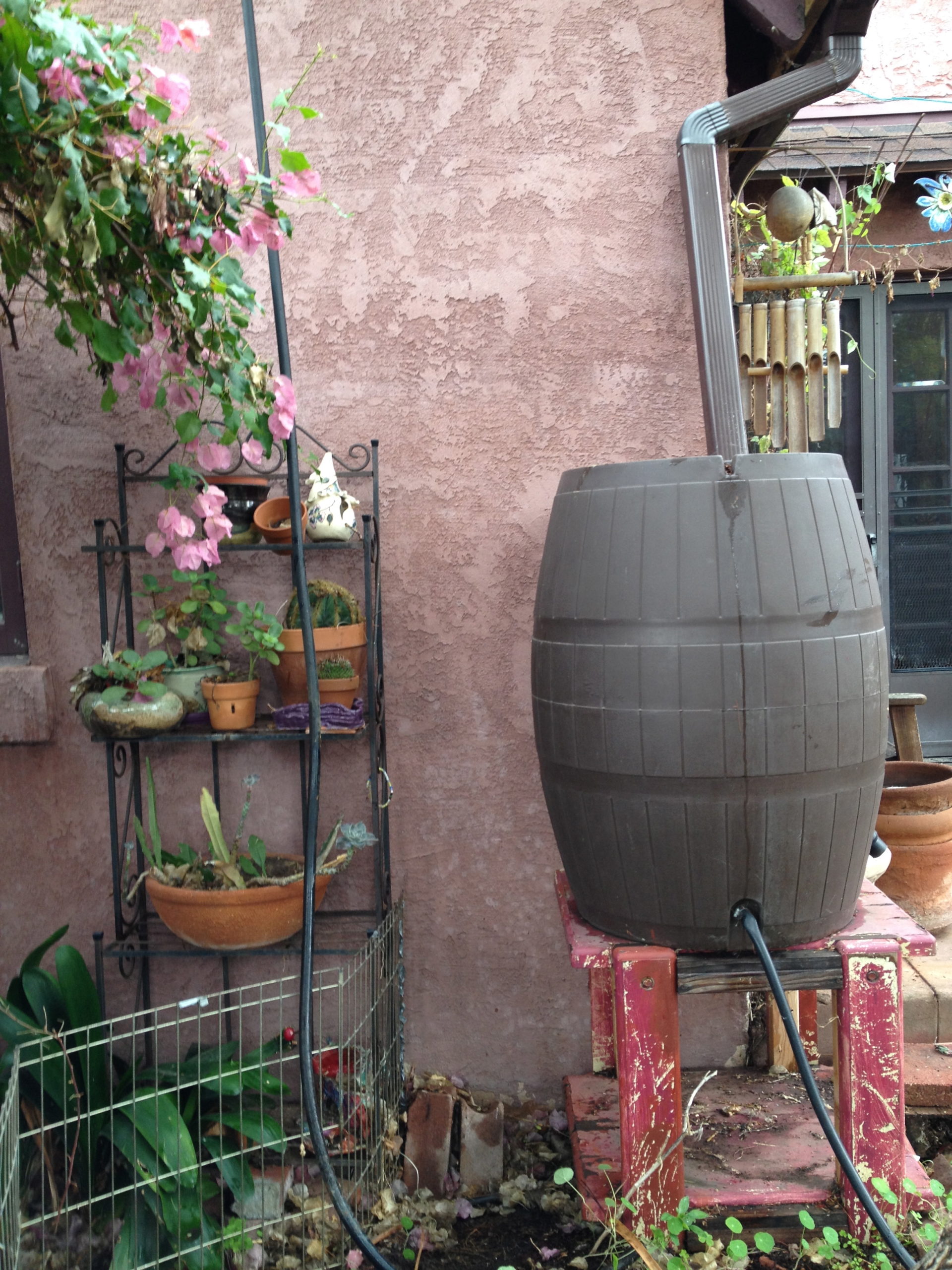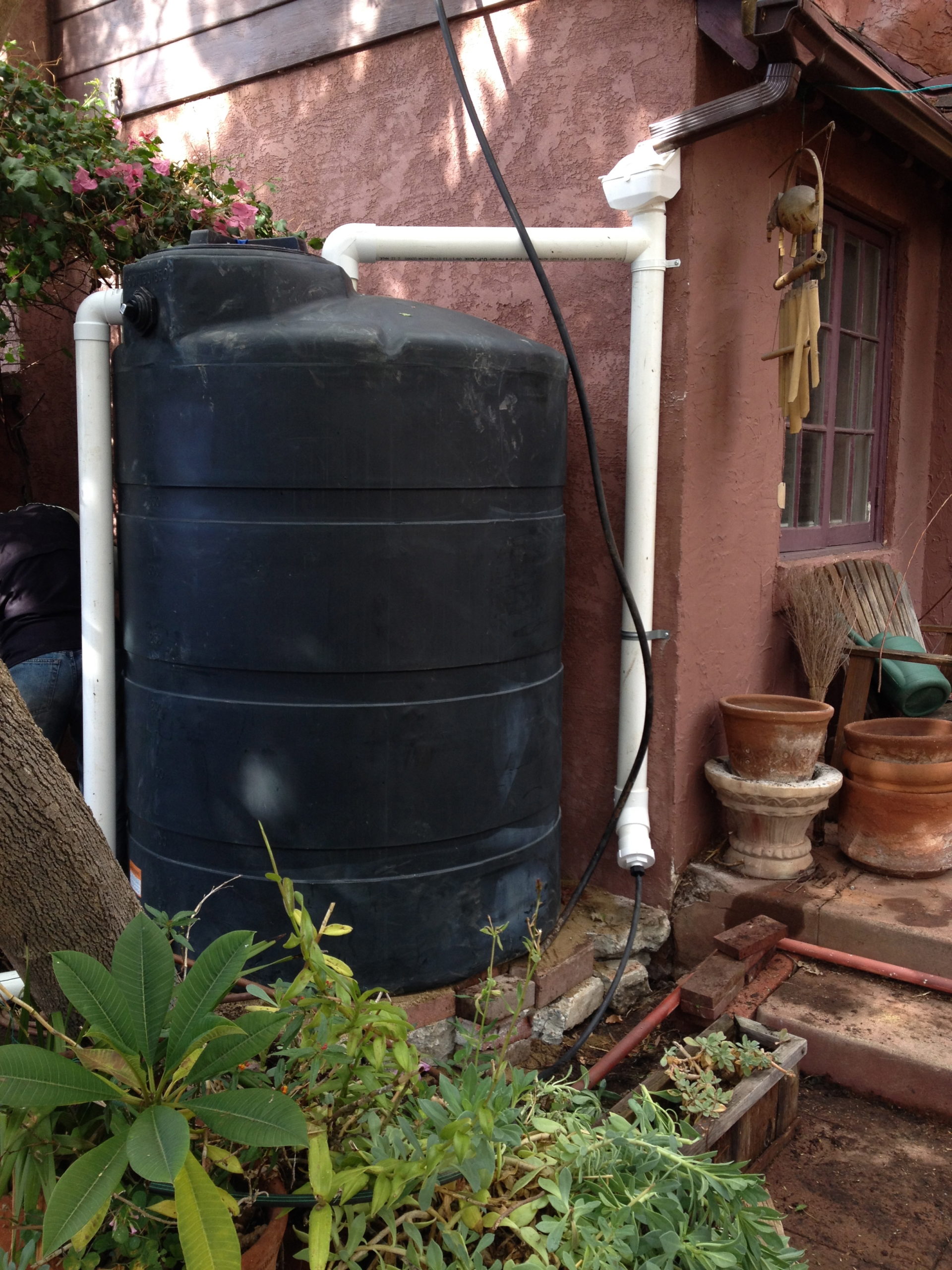I’ve noticed a growing trend this year, and I’d like to help you navigate your decisionmaking with a full tool belt of knowledge and resources. As drought statistics couple with wildly ranging El Nino predictions, I see many people rushing into decisions to get anything they can to catch a drop of water. This FOMO (Fear of Missing Out) may end up costing you money better spent toward your long term plan. It may be worth it to spend a little bit of extra money now so you don’t have to spend more money in the future once you realize your “barrel” isn’t really doing the job you hoped it would.
First of all it’s important to understand how much water we are talking about. When you begin to understand that hundreds of gallons are sheeting off your roof every time it rains, you’ll see that a barrel will catch an extremely small percentage of this year’s rainfall. With that understanding, you realize you can wait until even February to put in a 500 gallon or even 1500 gallon tank and it will still fill up.
Check out this rainwater harvesting calculator to find out how much water your can harvest from your roof annually, or just type in a 0.5″ average San Diego rainfall event to find a minimum storage amount that could be useful. Or use this rule of thumb to estimate:

Obviously, catching rain is only useful if it has a purpose. While the “rain barrel” craze is well intentioned and has a purpose, what most people are catching is the marketing ploy of “hurry up and get yours”. Sometimes I feel pressured to buy a tomato plant when I’m walking into Home Depot because it’s the season, but then I remember that I’m not really going to remember to water that one tomato plant in the hurry of my day-to-day life and it will probably die, so why waste the money and the energy spent sprouting it and bringing it to the shelf just because I really like the idea of growing tomatoes this year.
Storing rainwater is a hugely functional and important structure that we need to add to Southern California our neighborhoods if we want to work toward long term water self-sufficiency (did you know that most of our water comes from hundreds of miles away at great energy inputs?). Understanding what rainwater stored in your backyard water will do for you is a key part of this functionality. Putting 55 vs 500 or 1500 gallons in context is extremely important to determine how to best invest your money.
If your family drinks a gallon of milk a week, does it make sense for you to buy a pint every day or get a gallon on Monday in the first place?
Do you know how much water you use?
- 55 gallons will flush your toilet 34 times. An average person flushes 5 times per day. So for a family of 4, this 55 gallons will last you about a day and a half.
- A 500 gallon tank will give you 312 flushes which will last you half the month.
- That doesn’t count showers, hand washing, dishwashing.
- Landscape alone accounts for 50-75% of our residential water use.
Realistically we are using this rainwater in our landscape because that is the simplest use for it (no filtering, no pumping, no dragging buckets around i.e. additional costs that make rainwater storage unjustifiable for most).
- A fruit tree uses on average 25 gallons of water a week in our climate (some much more, some quite a bit less). So that 55 gallon drum will allow you to water one fruit tree for 2 weeks.
- A 500 gallon tank will allow you to water 10 fruit trees for 2 weeks.
- A 50 gallon barrel might supply 2 days – 1 week of water for a productive 10×10 veggie box, depending on what you are growing and your soil conditions.
- A 500 gallon tank may supply that same veggie box for 1-2 months.
Rebates are great, but don’t be convinced that you can get something useful free with your rebate.
Everything comes at a cost. In this case, a “free” barrel may cost you maintenance issues as well as be an inefficient part of your yard that eventually you stop using and sits around gathering dust with all the other “cool” things that sounded useful but don’t work so well for you in reality.
Beware of the idea that rainwater storage is a financially sound investment.
The truth is water delivery from the city of San Diego costs less than $0.05 for the first tier and up to $.008 for the fourth tier (you can find this information on your water agencies website). You can’t get rainwater storage for anywhere near this, not even with rebates!
Rainwater storage is vitally important as a piece of our water security here in San Diego. The trade off is between individual investment in onsite storage, water pricing rising to levels that will support water agencies resolving water delivery issues at a technological level (fraught with the financial inefficiencies that beaurocracies have), or having further cutbacks in individual usage as water scarcity becomes more pressing. Or maybe all three. As water prices rise to more accurately reflect true water value, a rainwater tank will actually be a way to “save money”, and people will be forced to use less water anyway.
Reasons why people opt to invest in larger storage after starting with a barrel:
- After seeing how quickly the barrels fill up and how quickly the water is used up, they realize that they want to store a more significant portion of their rainfall potential
- The water in the barrels quickly gets algae and particulates in it that need to be cleaned out frequently. With larger storage, you invest in very simple pre filtration that eliminates this constant disconnection of the barrel and maintenance.
- Few barrels are truly mosquito proof because the connections are cheaper plastic and temporary in nature. This eventually becomes a problem for many, easily eliminated with larger more permanent solutions.
- The spigots are extremely inefficient on the small barrels, usually plastic small diameter outlets causing tons of friction loss for already low pressure gravity fed systems. Many people find that they don’t bother using this water in liu of the faster gratification of municipal hose fed hand watering or drip irrigation.
- By upgrading to larger tanks, gravity is already improved by the height of the water level.
- Adding height by installing a raised platform for the tanks creates further pressure improvement.
- Installing high quality full port spigots becomes more worthwhile when spending the money to install a more permanent system, which results in less friction loss meaning better water pressure.
- It’s possible to put these more efficient systems on soaker hoses with timers, or connect them to pumps with small irrigation systems to create efficient watering setups.
- Additionally on some barrels the spigot is placed a relatively large distance from the bottom of the tank meaning getting to a majority of the water is not as simple as using the spigot. You may have to tip the tank over, hand bucket, or create another attachment at the very bottom of the tank.
After dealing with these frustrations and having spent sometimes several hundred dollars, most of these clients decide that spending money on a consultation to get a long term plan in place for integrated water strategies that can help create energetic and monetary efficiencies is worth investing in. A $200 consultation can easily save you $200+ by allowing you to avoid that first wasted investment in inefficient infrastructure.
Proudly H2OME specializes in making sure that you get an individualized plan that maximizes efficiencies in costs, materials, water use, and energy, as well as taking into account the things that matter to you in your daily rhythms and in your yard. We also collaborate with many of our colleagues in Southern California to stay abreast of what is working, what is not working, what products are best, and who are the best resources for a variety of different solutions. We believe everyone should be able to implement water conservation strategies, money should not prevent you from getting started making positive change, and no one needs to have a barren garden because of water scarcity. There is so much that can be done for little to no cost!
We offer hands-on workshops all over southern california, as well as apprenticeships, do-it-yourself one-on-one installations, and I love speaking to businesses, schools and communities.


